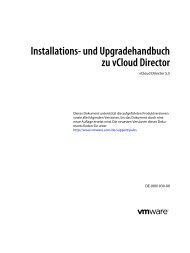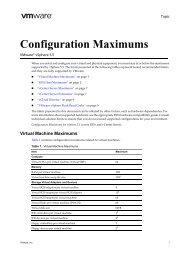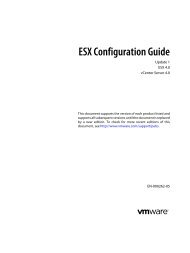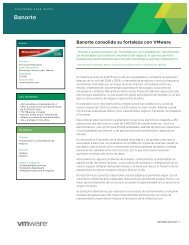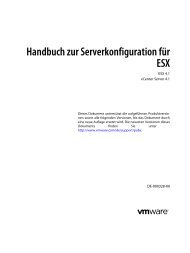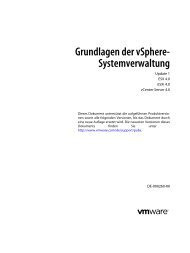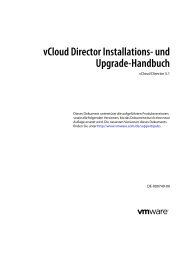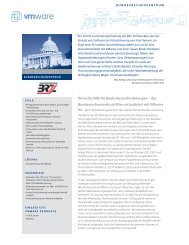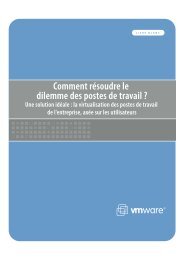Getting Started with vFabric Hyperic v.5.7 - VMware
Getting Started with vFabric Hyperic v.5.7 - VMware
Getting Started with vFabric Hyperic v.5.7 - VMware
You also want an ePaper? Increase the reach of your titles
YUMPU automatically turns print PDFs into web optimized ePapers that Google loves.
Changing from Unidirectional to Bidirectional Communications1. Stop the agent.2. Remove the agent's data directory.Removing the data directory will cause the agent, at next startup, to look for the startupsettings it needs to connect to the HQ Server in its agent.properties file; if theproperties file doesn't contain them, it will prompt for settings in the shell.3. Configure the agent for bidirectional communications using one of these methods:o If your practice is to provide all agent startup properties in the properties file, editagent.properties to set agent.setup.unidirectional=no, and startthe agent.o If your practice to configure the agent startup properties interactively, start theagent, and when prompted for communications direction, respond "no" whenasked if the agent should be configured to run in uni-directional mode.4. In the HQ user interface, navigate to the platform's Inventory tab and click Edit in the"Type & Network Properties" selection.5. Select the appropriate agent in the "Agent Connection" drop down.In the edit view for "Type & Network Properties", the "Agent Connection" drop-down listwill show your currently selected port for unidirectional communications, something like10.2.0.213:-1, where 10.2.0.213 is the IP address of the platform, and -1 is the portnumber.6. Expand the drop-down list and select the entry that shows the same IP address, and"2144" as the port (or the port you are configured to use, if not the default), for example,10.2.0.213:2144Your agent will now use bidirectional communications.Install or Configure <strong>vFabric</strong> <strong>Hyperic</strong> LicenseLicense Types in <strong>vFabric</strong> <strong>Hyperic</strong>In addition to being available as a standalone product, <strong>vFabric</strong> <strong>Hyperic</strong> is part of several<strong>VMware</strong> product sets — <strong>VMware</strong> <strong>vFabric</strong> Suite, <strong>VMware</strong> vCenter Operations ManagementSuite, and vClould Suite — each <strong>with</strong> its own licensing mechanism.If you obtained <strong>vFabric</strong> <strong>Hyperic</strong> standalone, or as part of <strong>vFabric</strong> Suite, you configure <strong>vFabric</strong>licensing.If you obtained <strong>vFabric</strong> <strong>Hyperic</strong> as part of vCenter Operations Management Suite, you configurevCenter Operations Management Suite licensing.If you obtained <strong>vFabric</strong> <strong>Hyperic</strong> as part of vCloud Suite, you configure vCloud licensing.Note that if you have more than one license, you configure each of them, as described in thesections that follow.100




